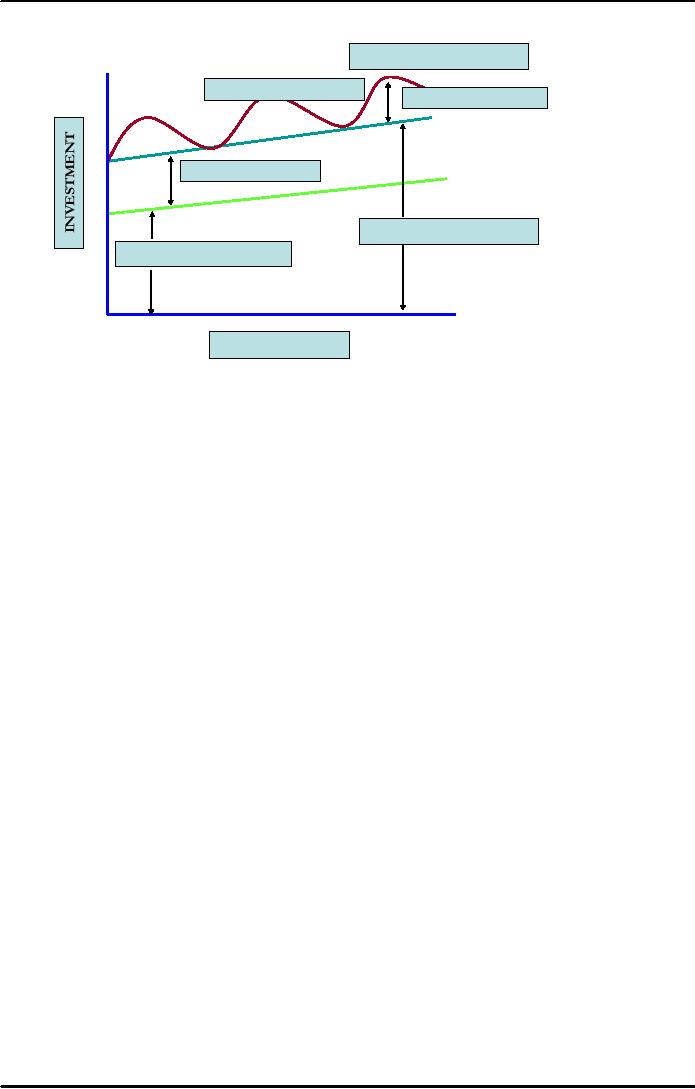 |

Corporate
Finance FIN 622
VU
Lesson
27
WORKING
CAPITAL MANAGEMENT
The
following topics will be
discussed in this lecture.
Classification
of working capital
Current
Assets Financing Hedging
approach
Short term Vs
long term financing
Risk
of short & long term financing
Trade
off of short & long term
financing
Classifications
of Working Capital
Working
capital or current assets can be
classified according to
- Components:
like inventory, cash,
securities, receivables
- Time
basis: it may be temporary or
permanent.
Temporary
working capital is the amount of investment in current
assets that varies according
to the
seasonal
requirements. For example,
consider an ice cream manufacturing
firm. During the months of
May
September the manufacturer has to
keep the maximum inventory to support
high level sales. During
off-
season
like from November to
January the sales are
extremely low and lower
investment in inventory is
required.
Now consider if a festival like
Eid or Christmas is falling
during December and this
would result
in
high sales, then a temporary
increase in inventory would be required
to support this sale level.
Permanent
working capital is the minimum investment
in current assets that is required
support long-term
minimum
need. Permanent working
capital resembles to fixed
assets in two aspects. First the
dollar
investment is
long term despite contradiction
that assets being financed are
called `current'. Second,
for a
growing
firm, the need to increase the
minimum permanent working
capital is the same as of fixed
assets.
However,
there is a case of difference between the
permanent working capital
and fixed asset that
is the
later
always changing
constantly.
Like
permanent working capital, temporary
working capital also
comprises of current assets in a
constantly
changing
form. However, because the
need for this part of the
firm's total current assets is
seasonal, we
want to
consider financing this level of current
assets from a source which
can itself be seasonal
or
temporary in
nature. In the next section we
pick up the problem of how to
finance current assets.
Short
Term & Long Term
Mix
Investment
in current asset does involve a
trade off between the risk
and profitability. As a matter of
fact
the current
liabilities side of working
capital does not consist of
active decision variables in the
sense; you
cannot defer
payment to creditors beyond certain
limits. Same is true for accrued
expenses like electricity,
payroll
etc. There's no big room
for playing with current liabilities
which are also termed as
spontaneous
source
of finance. As the underlying investment in current
assets grows, accounts
payable and accruals
also
tend to grow, in
part financing the increase in
assets. The issue here is
how to handle assets not
supported
by
spontaneous financing. This is termed as
residual financing requirements
that is net investment after
deducting
spontaneous financing.
Current
Assets Financing Hedging
Approach
Under
this approach each asset
would be offset with a
financing instrument of the same
maturity. Short
term
seasonal investment requirements should be financed
through short term loans and
permanent current
asset
and all fixed assets should
be financed through long term loan
and equity. This can be illustrated
from
the
following figure:
90

Corporate
Finance FIN 622
VU
HEDGING
POLICY
TEMPORARY
CA
SHORT TERM
LOANS
PERMANENT
CA
LONG TERM
LOANS
NON CURRENT
ASSETS
TIME
This
shows that financing will be
employed even when it is not
needed. With a hedging approach
to
financing, the
borrowing and payment
schedule for short term financing
would be arranged to
correspond
to the
expected swings in current assets
less spontaneous financing.
The
rational behind hedging
policy that if long term
loans are used to finance
the short term or temporary
current
assets then the firm will be
paying interest when the funds are
not actually needed. It is
clear from
the
graphical view of the hedging policy
that loans will only be
employed during the seasonal
need period.
Hedging
approach to financing suggests
that apart from current
installments on long term debt, a
firm
should
not employ current borrowings during
seasonal troughs for asset
needs as per the above figure.
As
the
seasonal need asset arises
it will borrow on short term basis.
This loan will be used to
pay off the
borrowing
with the cash released as the
recently financed temporary assets were
eventually reduced. For
example,
a seasonal increase in inventory
for Eid selling will be
financed with a shot term loan. As
the
inventory
was reduced through sales,
debtors will be built up.
The cash needed to repay the
loan would
come
from the collection from
debtors. In this way financing
will only be employed when
needed.
Thus
loan to support seasonal
need would generate
necessary fund to repayment in
normal course of
operation.
This is known as self-liquidating
principle.
Short
Term Vs Long Tem
Financing
Although
the exact maturity matching of
future cash flow and
debt repayments is possible under
conditions
of certainty
but it is not appropriate when surrounded by
uncertainty. Net cash flow
will be off from the
estimates
keeping in view the firm's business
risk. Resultantly the schedule of
maturities of debt is very
significant in
assessing the risk-profitability trade
off.
In
general the shorter the maturity schedule
of a firm's debt, the greater the risk
that fir firm will
default on
principal
and interest payment.
Suppose a firm seeks a short term
loan for capital expenditure.
The cash
flows
from the capital expenditure will
not be sufficient in the short run to
pay off the loan. As a result,
the
company
bears the risk that the lender may
not renew the loan at
maturity. This refinancing risk could be
reduced
in the first place by financing the
plant on a long term basis the
expected loan term future
cash
flows
being sufficient to retire the debt in an
orderly manner. Thus
committing funds to a long term
asset
and
borrowing short term carries the risk
that the firm may not be
able to renew it loan. If the company
is
surrounded by
bad times, the creditors
might regard renewal as too
risky and demand immediate
payment.
Apart
from refinancing risk, uncertainty is
there associated with
interest cost. When firm
finances with long
term
loans it is aware of exact
interest cost over the
period of time for which
loans are needed. If it
uses
short term
loans then it is uncertain of interest
cost. Secondly, we are well
aware that short term
interest
91

Corporate
Finance FIN 622
VU
rates
fluctuate more than long
term. A firm forced to finance its short
term debt in a period of high
interest
rates
may pay on overall interest
cost on short term loan that is higher
than it would have been
originally on
long
term loan. In short not knowing the short term
interest cost of loans is to
some extent a risk to the
company.
The
Risk Vs Cost Trade off:
The
risk between long and short term
financing should be balanced against the
interest costs. The
longer
the
maturity schedule of loan, the more
expensive will be the financing. Further
to this, the firm will be
paying
interest cost on loans when
the loans / debts are not
needed. Therefore, there are
cost inducements
to
finance funds requirements on a short term
basis.
Eventually
we can work out the trade
off between risk and
profitability. As per our
discussion over last
couple
of pages, we know that short term
loans have greater risk than
long term loans but are
comparatively
cheap.
The margin of safety would
depend on the variance between the
cash flow and payment of
debt.
Also,
margin of safety will depend
on the risk preference of the
management.
The
management will finance a
part of its expected
seasonal investment, less payables
and accruals on long
term
basis. If there's no deviation in
cash flow as estimated, the
firm will pay interest on
excess debt during
seasonal
dips when the funds are not
needed. Peak season
requirements can be financed through
long term
loan.
The higher the long term loans the
more conservative financing
policy and therefore, the higher
interest
cost.
Under
aggressive policy the firm
would finance part of its
permanent current asset with short term
debts.
This
would require that firm must
renew the debt at maturity, which
represents some risk to the firm.
The
greater
the portion of permanent assets financed
with short term loans, the more
aggressive the policy is.
In
this
case, the expected margin of safety
linked with firm's policy
can be negative, positive or
even zero.
Now we
are in a position to sum up
our discussion or conservative
and aggressive policies.
Here are the
salient
features of both policies
with regard to investment in current
assets:
Conservative
Policy:
o Firm
finances a part of seasonal
fund requirements less
accounts payable on long term
basis.
o If
cash flow estimates do not
deviate far from actual, it
will pay interest on debt
when actually
funds
are not needed.
o Higher
the long term financing line,
more conservative policy and
higher cost.
Aggressive
Policy:
Part
of permanent current assets is financed
with short term debt.
o
The
company must arrange renewal
of short term debt. It involves risk.
o
The
greater portion of permanent current
assets is financed with short term debt,
more
o
aggressive
policy it is.
Expected margin of
safety regarding ST <> LT financing
can be positive, negative or
o
neutral. Later
would be hedging policy.
Margin
of safety can be increased by
increasing the liquid
assets.
o
Risk
of cash insolvency can be
reduced by stretching the maturity
schedule of debt or
o
carrying
larger amounts of current
assets
92
Table of Contents:
- INTRODUCTION TO SUBJECT
- COMPARISON OF FINANCIAL STATEMENTS
- TIME VALUE OF MONEY
- Discounted Cash Flow, Effective Annual Interest Bond Valuation - introduction
- Features of Bond, Coupon Interest, Face value, Coupon rate, Duration or maturity date
- TERM STRUCTURE OF INTEREST RATES
- COMMON STOCK VALUATION
- Capital Budgeting Definition and Process
- METHODS OF PROJECT EVALUATIONS, Net present value, Weighted Average Cost of Capital
- METHODS OF PROJECT EVALUATIONS 2
- METHODS OF PROJECT EVALUATIONS 3
- ADVANCE EVALUATION METHODS: Sensitivity analysis, Profitability analysis, Break even accounting, Break even - economic
- Economic Break Even, Operating Leverage, Capital Rationing, Hard & Soft Rationing, Single & Multi Period Rationing
- Single period, Multi-period capital rationing, Linear programming
- Risk and Uncertainty, Measuring risk, Variability of return–Historical Return, Variance of return, Standard Deviation
- Portfolio and Diversification, Portfolio and Variance, Risk–Systematic & Unsystematic, Beta – Measure of systematic risk, Aggressive & defensive stocks
- Security Market Line, Capital Asset Pricing Model – CAPM Calculating Over, Under valued stocks
- Cost of Capital & Capital Structure, Components of Capital, Cost of Equity, Estimating g or growth rate, Dividend growth model, Cost of Debt, Bonds, Cost of Preferred Stocks
- Venture Capital, Cost of Debt & Bond, Weighted average cost of debt, Tax and cost of debt, Cost of Loans & Leases, Overall cost of capital – WACC, WACC & Capital Budgeting
- When to use WACC, Pure Play, Capital Structure and Financial Leverage
- Home made leverage, Modigliani & Miller Model, How WACC remains constant, Business & Financial Risk, M & M model with taxes
- Problems associated with high gearing, Bankruptcy costs, Optimal capital structure, Dividend policy
- Dividend and value of firm, Dividend relevance, Residual dividend policy, Financial planning process and control
- Budgeting process, Purpose, functions of budgets, Cash budgets–Preparation & interpretation
- Cash flow statement Direct method Indirect method, Working capital management, Cash and operating cycle
- Working capital management, Risk, Profitability and Liquidity - Working capital policies, Conservative, Aggressive, Moderate
- Classification of working capital, Current Assets Financing – Hedging approach, Short term Vs long term financing
- Overtrading – Indications & remedies, Cash management, Motives for Cash holding, Cash flow problems and remedies, Investing surplus cash
- Miller-Orr Model of cash management, Inventory management, Inventory costs, Economic order quantity, Reorder level, Discounts and EOQ
- Inventory cost – Stock out cost, Economic Order Point, Just in time (JIT), Debtors Management, Credit Control Policy
- Cash discounts, Cost of discount, Shortening average collection period, Credit instrument, Analyzing credit policy, Revenue effect, Cost effect, Cost of debt o Probability of default
- Effects of discounts–Not effecting volume, Extension of credit, Factoring, Management of creditors, Mergers & Acquisitions
- Synergies, Types of mergers, Why mergers fail, Merger process, Acquisition consideration
- Acquisition Consideration, Valuation of shares
- Assets Based Share Valuations, Hybrid Valuation methods, Procedure for public, private takeover
- Corporate Restructuring, Divestment, Purpose of divestment, Buyouts, Types of buyouts, Financial distress
- Sources of financial distress, Effects of financial distress, Reorganization
- Currency Risks, Transaction exposure, Translation exposure, Economic exposure
- Future payment situation – hedging, Currency futures – features, CF – future payment in FCY
- CF–future receipt in FCY, Forward contract vs. currency futures, Interest rate risk, Hedging against interest rate, Forward rate agreements, Decision rule
- Interest rate future, Prices in futures, Hedging–short term interest rate (STIR), Scenario–Borrowing in ST and risk of rising interest, Scenario–deposit and risk of lowering interest rates on deposits, Options and Swaps, Features of opti
- FOREIGN EXCHANGE MARKET’S OPTIONS
- Calculating financial benefit–Interest rate Option, Interest rate caps and floor, Swaps, Interest rate swaps, Currency swaps
- Exchange rate determination, Purchasing power parity theory, PPP model, International fisher effect, Exchange rate system, Fixed, Floating
- FOREIGN INVESTMENT: Motives, International operations, Export, Branch, Subsidiary, Joint venture, Licensing agreements, Political risk